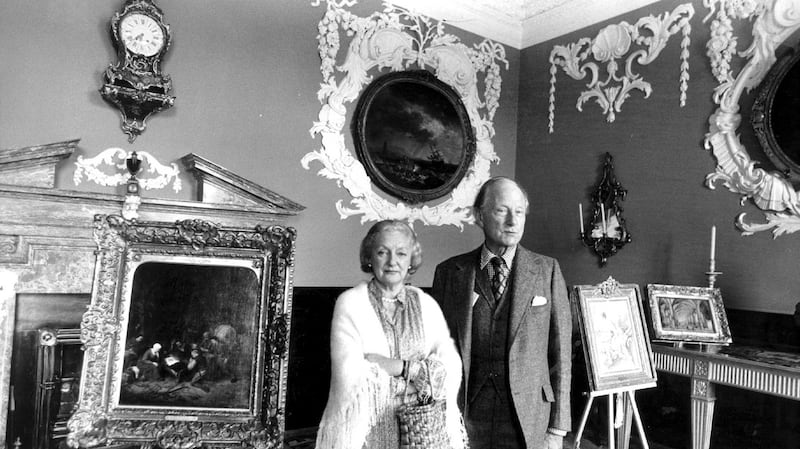For a few decades in the second half of the 20th century, Russborough House near Blessington, Co Wicklow was an unlikely home to one of the world's most important – and valuable – privately owned art collections. But not any more. So where did all the art go, and who owns it now?
In the 1950s, the opulent Anglo-Irish mansion was bought by English aristocrat Sir Alfred Beit, heir to both a diamond-mining fortune and a stunning collection of paintings. He and Lady Beit moved to Co Wicklow, settled into Irish country life and adorned Russborough House with museum-quality works of art and antiques.
The couple had no children and so, after two decades, in 1976 they effectively handed over the house and their art collection to the people of Ireland by establishing the Alfred Beit Foundation, a charitable and educational trust "with the object of keeping the house and art collection intact, making it a centre for the arts and open to the public".

Russborough House was opened to visitors but the art, inevitably, attracted the attention of criminals. Many of the paintings were stolen in a series of notorious robberies – among them one by an IRA gang that included, improbably, the heiress Rose Dugdale. (Most were later recovered by the Garda.) As a consequence, in 1986 the Beits donated the most valuable of the paintings, including a Vermeer, to the National Gallery of Ireland. This act of astounding generosity was worth an estimated €100 million.
In 1993, in a first for British subjects, the couple were granted honorary Irish citizenship. Sir Alfred died the following year, aged 91; Lady Beit died in 2005, aged 89.
Short of money
Meanwhile, the foundation got on with the job of running Russborough House and attracting visitors. The house did receive some funding from the State but, evidently, not enough. Cash was needed to pay for ongoing maintenance and conservation. But how to raise it? The oldest solution in the Big House book, of course: was to “sell the family silver”.
In 2006, the foundation sold a collection of 16th-century Italian bronze sculptures at auction, which made €3.8 million. When that cash ran out, a small collection of Chinese porcelain was sent to Sotheby’s in 2013. Initially valued at €350,000, the porcelain sold for €1.2 million.
The financial problems persisted. In 2015, the foundation announced that it needed to create an endowment fund to pay for ongoing running costs and conservation; otherwise Russborough House might have to close. It also announced plans to sell some of the remaining Beit art collection – including six "Old Master" paintings, among them two works by Rubens – at a Christie's auction in London.
The foundation said the paintings had been in storage for years and would not be hung in the house again because of security concerns. However, the proposed auction prompted a public outcry. After a series of emergency meetings with Minister for Arts and Heritage Heather Humphreys, the foundation agreed to postpone the auction of the Old Master paintings until 2016. It would attempt to find private sources in Ireland who might buy the paintings and donate them to the State.
Following months of secret negotiations, it emerged that buyers had been found for three of the six paintings for donation to the National Gallery of Ireland. These purchases aren’t quite as kind-hearted as they may appear. Such donors are entitled to 80 per of the price written off their tax liabilities. So the State, in fact, ends up footing most of the cost in foregone taxes.
Humphreys’s department said it would not name the donors as the arrangements involved their private tax affairs. But the details have emerged.
Anonymous buyers
Denis O'Brien, the telecoms billionaire, bought Head of a Bearded Man by Rubens for €3.5 million, which enables him to claim €2.8million in tax relief. Lochlann Quinn, part-owner of Dublin's five-star Merrion Hotel, bought A Village Kermesse Near Antwerp by David Teniers the Younger, a 17th-century Flemish artist, for €2 million (tax relief worth €1.6 million).
It is believed that Dublin businessman John Gallagher (who has made no public comment on the matter) is willing to buy a third painting, Adoration of the Shepherds by Adriaen Van Ostade, for €1 million, which would entail tax relief of €800,000. The Department of Arts & Heritage said the process to agree a valuation for the Van Ostade painting, which must be approved by the Revenue Commissioners, is still ongoing.
As for the other three Old Masters, they were sent back to the salesroom. Last July 7th three lots "consigned by the Alfred Beit Foundation" were sold by Christie's in London. Venus Supplicating Jupiter by Rubens made £1.3 million (€1.5 million at the prevailing exchange rate); Piazza San Marco, Venice, with the Basilica and the Campanile, with Figures in Carnival Costume by Francesco Guardi made £164,500 (€192,000); and Guardi's The Piazzetta, Venice, with the Doge's Palace and the Libreria, San Giorgio Maggiore Beyond, also made £164,500.
Will these sales prevent the threatened closure of Russborough House? For the foreseeable future, almost certainly yes. But the long-term fate of the house, and its remaining treasures, is uncertain.



















